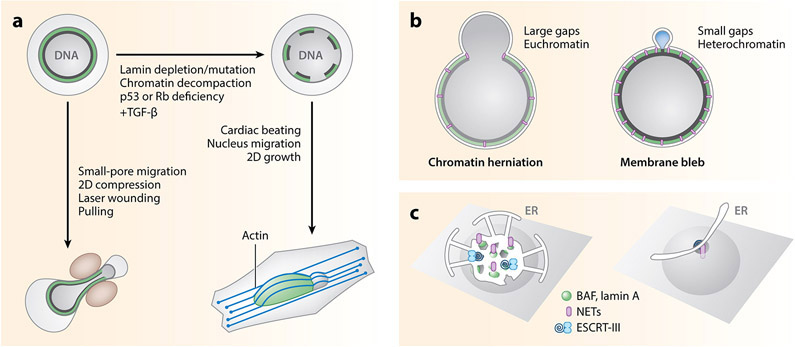Figure 2.
Mechanisms of nuclear membrane rupture and repair. (a) The probability of nuclear membrane rupture depends on the degree of nuclear lamina (green) and peripheral heterochromatin (dark gray) disruption and the degree of mechanical stress. In healthy cells with an intact nuclear lamina, membrane rupture requires a significant amount of force, such as laser-induced rupture or (left) cell migration through a small opening. Disruption of the nuclear lamina by depletion or mutation of lamin proteins, chromatin decompaction, loss of retinoblastoma (Rb) and p53 activity, and activation of EMT genes by TGF-β signaling leads to membrane rupture in less mechanically demanding conditions, such as growth on stiff surfaces where (right) nucleus compression by apical actin bundles drives chromatin herniation and membrane rupture. (b) Nuclear membrane rupture is frequently preceded by or occurs with chromatin herniation and nuclear membrane blebbing. Chromatin herniation, where little to no gap is visible between the membrane and the extruded chromatin, is associated with conditions that cause large lamina gaps and decreased heterochromatin, while membrane blebbing without chromatin is associated with more intact nuclear laminas and significant peripheral heterochromatin. (c) Models of nuclear membrane repair. (Left) Cytosolic BAF binds to exposed chromatin and recruits LEM-domain NETs (purple) embedded in ER sheets and tubules. BAF also recruits lamin A/C and the NET LEMD2, which recruits the ESCRT-III complex. Depletion of BAF, ESCRT-III, or multiple NETs leads to impaired membrane repair. (Right) Alternatively, direct binding of NETs and the ESCRT-III protein Chmp7 to the chromatin and inner nuclear membrane, with or without membrane recruitment, or spreading of the outer nuclear membrane over the membrane gap could recompartmentalize the nucleus in the absence of BAF. Abbreviations: BAF, barrier-to-autointegration factor; Chmp7, charged multivesicular body protein; EMT, epithelial-to-mesenchymal transition; ER, endoplasmic reticulum; ESCRT-III, endosomal sorting complexes required for transport III; LEMD, Lap2, emerin, and Man1 domain; NET, nuclear envelope transmembrane protein; TGF, transforming growth factor.

